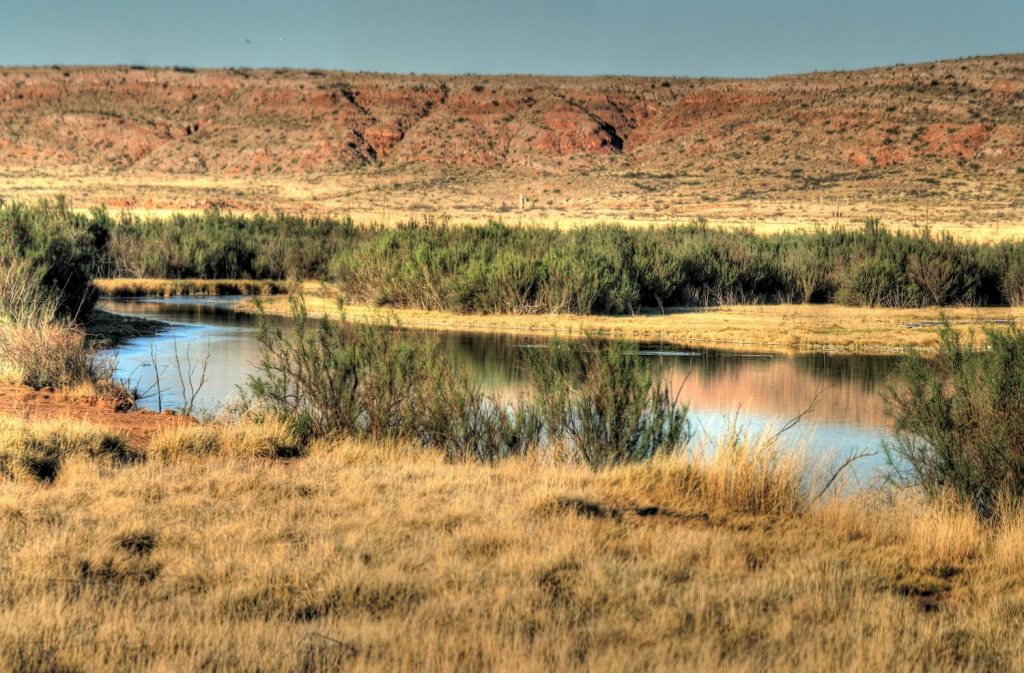📷 Oxbow at Bitter Lake National Wildlife Refuge, New Mexico | Joel Deluxe
Roswell, NM – Something exciting has touched down in Roswell— and this time, it’s not from another planet. The National Wildlife Refuge Association is thrilled to welcome Marianne Kelso as our new biologist at Bitter Lake National Wildlife Refuge (NWR), where she’s bringing her skills, smarts, and species-saving know-how to southeastern New Mexico’s Pecos River watershed.
Marianne Kelso, our new Biologist at Bitter Lake National Wildlife Refuge, NM
Bitter Lake NWR might be just a few miles from UFO hotspots and alien museums, but its real wonders are earthly and extraordinary. As part of the Roswell Artesian Wetlands Ramsar Wetland of International Importance, this unique refuge sits at the intersection of the Chihuahuan Desert, the Pecos River, shortgrass prairie, and the Roswell Artesian Basin. It provides critical habitat for endangered and endemic species like the Pecos sunflower, Roswell springsnail, Noel’s amphipod, and Pecos pupfish, and serves as a vital migratory stopover along the Central Flyway.
Marianne joins the Refuge Association team through a multi-year, grant-funded initiative supported by the National Fish and Wildlife Foundation’s Pecos Watershed Conservation Initiative, which aims to restore habitat, manage invasive species, and bolster ecosystem resilience across the region.
This role is part of a growing tradition of on-the-ground conservation at Bitter Lake NWR. Marianne is continuing the work of past National Wildlife Refuge Association biological technicians— including Anna Lee, Tegan Robert, and JC Boothe, who was recognized as the Early Career Conservationist of the Year for the U.S. Fish and Wildlife Service Southwest Region in 2022. Their efforts, along with an American Conservation Experience crew helped launch critical projects such as wildlife-friendly fencing for pronghorn migration, invasive species removal, and restoration of sensitive wetland habitats. Marianne’s arrival ensures that this important work continues.
“Marianne brings a rare blend of experience, passion, and grit to Bitter Lake National Wildlife Refuge— a place unlike any other, nestled in the heart of the Pecos River watershed,” said Desirée Sorenson-Groves, President & CEO of the National Wildlife Refuge Association. “This ecosystem is teeming with life found nowhere else on Earth, and with support from the National Fish and Wildlife Foundation, we’re proud to continue putting boots on the ground to protect it. At a time when federal staffing shortfalls threaten the future of national wildlife refuges, Marianne’s work is not only timely— it’s essential.”
Originally from North Carolina, Marianne’s journey into conservation began after a transformative AmeriCorps term with the Utah Conservation Corps shifted her focus from veterinary medicine to wildlife biology. She holds a M.S. in Biology from Grand Valley State University and has contributed to the recovery of a wide range of federally threatened, endangered, and regionally endemic species, including the Mojave Desert tortoise, Utah prairie dog, Mariana crow, and Woundfin.
At Bitter Lake NWR, Marianne will work closely with U.S. Fish and Wildlife Service refuge staff to lead crews of interns and technicians on habitat restoration projects. Her primary focus includes managing invasive species such as salt cedar, advancing climate adaptation efforts, and improving habitat conditions for federally threatened and endangered fish, invertebrate, and plant species. She’ll also conduct waterbird surveys, monitor rare plants and aquatic wildlife, and contribute to daily refuge operations— all a part of a long-term commitment to conservation in one of the country’s most biologically unique landscapes.
For questions related to conservation efforts at Bitter Lake NWR, Marianne can be reached at mkelso@refugeassociation.org.

